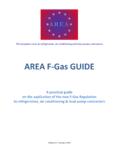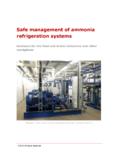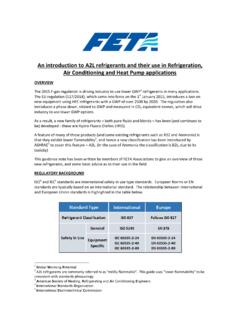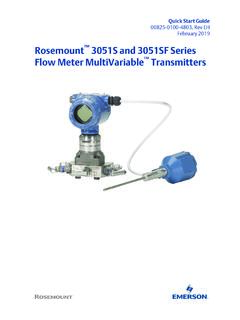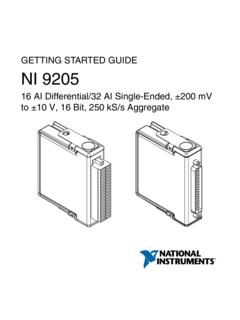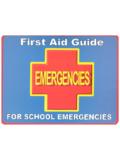Transcription of Guide to - Refcom
1 Guide to Flammable Refrigerants Issue 1, October 2012 Supported by the HEVAC Air Conditioning Group and the Heat Pump Association BRA Guide to Flammable Refrigerants, Issue 1, October 2012 Page | 1 Guide to Flammable Refrigerants This Guide has been prepared by Cool Concerns Ltd at the request of the Council of the British Refrigeration Association (BRA) because of the increase in the application of flammable refrigerants such as hydrocarbons, HFOs and flammable HFCs. It provides impartial information about the flammability issues associated with these refrigerants to end users, specifiers, building owners, manufacturers and contractors. It is an introduction to flammable refrigerants and signposts where more detailed information can be obtained if necessary. Scope of this Guide : Hydrocarbons (HCs); Hydrofluoroolefins (HFOs); Flammable hydrofluorocarbons (HFCs). Ammonia (R717) is not included in this Guide .
2 Section 10 shows where there is detailed information about R717. This Guide applies to the use of flammable refrigerants in new, specially designed systems. Existing systems using non-flammable refrigerants must not be retrofitted to flammable refrigerants. At the time of publication many of the standards referred to in this document are in revision. This includes EN378, ISO 5149 and ISO 817. The text indicates which versions are referenced in this document. Refer to the British Standards Institute for details of revisions. For full information .. This Guide is an introduction to flammable refrigerants. In many instances more detailed information is essential. It is recommended that the application and installation of systems using flammable refrigerants are checked, for example by an independent expert. This should include confirmation that: The system has been produced to specification and to the relevant regulations and standards; The system charge does not exceed the limits appropriate for its location; Sources of ignition are not located in a potentially flammable zone around a system charged with a flammable refrigerant; Appropriately trained and qualified engineers work on the equipment.
3 End users should be made aware that systems are charged with a flammable refrigerant. Where applicable, information about the minimum room size the equipment can be located in and the potentially flammable zone extent around the equipment should be provided. BRA Guide to Flammable Refrigerants, Issue 1, October 2012 Page | 2 Table of Contents 1. Introduction .. 4 Helpful definitions .. 4 2. Regulations, Standards and Codes of Practice .. 6 3. Transport of Flammable Gases in Cylinders and Equipment .. 8 Transport of cylinders by road .. 8 Transport of charged systems .. 8 4. Maximum Flammable Gas Charge Size .. 10 Comfort cooling / heating applications .. 10 Non comfort cooling / heating applications .. 10 Special machine rooms .. 14 5. Systems / Applications .. 15 6. Overview of Design .. 17 7. Overview of Manufacture .. 19 8. Overview of Service .. 20 Tools and equipment .. 20 Procedures .. 20 9. Training .. 21 10. Sources of Further Information.
4 22 Appendix 1, Example Label for a Flammable Refrigerant System .. 23 BRA Guide to Flammable Refrigerants, Issue 1, October 2012 Page | 3 Disclaimer Federation of Environmental Trade Associations Ltd 2012 All rights reserved. Apart from any fair dealing for the purposes of private study or research allowed under applicable copyright legislation, no part of the publication may be reproduced, stored in a retrieval system, or transmitted in any form by any means, electronic, mechanical, photocopying, recording or otherwise, without the prior permission of the Federation of Environmental Trade Associations, 2 Waltham Court, Milley Lane, Hare Hatch, Reading, Berkshire RG10 9TH. FETA uses its best efforts to promulgate Standards and Guidelines for the benefit of the public in the light of available information and accepted industry practices but do not intend such Standards and Guidelines to represent the only methods or procedures appropriate for the situation discussed.
5 FETA does not guarantee, certify or assure the safety or performance of any products, components, or systems tested, installed or operated in accordance with FETA's Standards or Guidelines or that any tests conducted under its Standards or Guidelines will be non-hazardous or free from risk. FETA, and the individual contributors, disclaims all liability to any person for anything or for the consequences of anything done or omitted to be done wholly or partly in reliance upon the whole or any part of the contents of this booklet. BRA Guide to Flammable Refrigerants, Issue 1, October 2012 Page | 4 1. Introduction The trend towards the use of flammable refrigerants has increased over the last decade. Hydrocarbons are now used widely in small integral systems as well as in some larger systems. HFOs such as R1234ze have lower flammability and are being introduced in trial applications. Flammable HFCs such as R32 are also starting to be used.
6 Helpful definitions HC = hydrocarbon naturally occurring substances containing only hydrogen and carbon; HFC = hydrofluorocarbon halocarbon containing only hydrogen, fluorine and carbon; HFO = hydrofluoroolefin halocarbon containing only hydrogen, fluorine and unsaturated carbon; Refrigerants are classified according to their flammability and toxicity. A classification indicates low toxicity ( B is high toxicity). The numbers 1, 2 or 3 following the A or B indicate the degree of flammability. The safety classifications below are defined in ISO817:2009 1 and are also used in EN378-1:2008 A2:20122. Safety classification Lower Flammability level, % in air by volume Heat of combustion, J/kg Flame propagation A1 No flame propagation when tested at 60OC and kPa A2, lower flammability > < 19,000 Exhibit flame propagation when tested at 60OC and kPa A2L, lower flammability, proposed sub classification > < 19,000 Exhibit flame propagation when tested at 60OC and kPa and have a maximum burning velocity of 10 cm/s when tested at 23OC and kPa A3, higher flammability 19,000 Exhibit flame propagation when tested at 60OC and kPa Note it is proposed to include the A2L safety classification in revisions of EN 378 and ISO 817.
7 It is already used in ASHRAE standards (American Society of Heating, Refrigeration and Air Conditioning Engineers) and is in de facto use, so it is included in this document. To highlight that it is not yet in the standards referenced here it will be shown as A2L (proposed) in the text of this document. 1 ISO817:2009 Refrigerants Definitions and safety classification. Note that the A2L classification is not yet adopted it is in the current proposed revision of ISO817. 2 EN378-1:2008+A2:2012, Refrigerating systems and heat pumps Safety and environmental requirements, Part 1 Basic requirements, definitions, classification and selection criteria BRA Guide to Flammable Refrigerants, Issue 1, October 2012 Page | 5 The table below lists the most common flammable refrigerants. There are many other flammable HFCs listed in various standards, but they are not used in the UK so have not been listed below.
8 Refrig. BP 1 Safety group 2 LFL, kg/m3 3 LFL, % 4 Auto ignition temp, OC PL, kg/m3 5 GWP 6 HC R600a -12 A3 460 3 HC R290 -42 A3 470 3 HC R1270 -48 A3 455 3 HC Care 30 7 -23 / -32 A3 460 3 HC Care 50 7 -43 / -49 A3 460 3 HFO R1234yf A2 A2L (proposed) 405 4 HFO R1234ze 7 -19 A2L (proposed) 8 288 to 293 6 HFC R32 A2 A2L (proposed) 648 550 HFC R143a -47 A2 750 4300 HFC R152a -25 A2 455 120 1. BP is the boiling point at atmospheric pressure. For zeotropic blends it is the saturated liquid (bubble) / saturated gas (dew) temperatures. 2. The safety group is as listed in EN378-1. 3. LFL (kg/m3) is the Lower Flammability Limit as listed in EN378-1. 4. LFL (%) is the Lower Flammability Limit as listed in ISO817:2009. 5. PL is the Practical Limit as listed in EN378-1. 6. GWP is the Global Warming Potential as listed in EN378-1. 7. These refrigerants are not listed in the current versions of EN378 or ISO817.
9 The information is from the refrigerant suppliers. 8. HFO1234ze does not exhibit flame limits under standard test conditions, but it does at temperatures above 30OC. The LFL stated is at 60OC. BRA Guide to Flammable Refrigerants, Issue 1, October 2012 Page | 6 2. Regulations, Standards and Codes of Practice There are regulations and standards which cover the use of flammable refrigerants. These, for example, cover the design of systems and components, specify maximum refrigerant charge sizes, specify how cylinders and charged systems should be transported and outline the required competence of engineers. ATEX is the name commonly given to the legal requirements for controlling explosive atmospheres and the suitability of equipment and protective systems used in them. ATEX 95 (94/9/EC) covers the design of equipment and protective systems intended for use in potentially explosive atmospheres. ATEX 137 (99/92/EC) covers the minimum requirements for improving the safety and health protection of workers potentially at risk from explosive atmospheres.
10 It applies, for example, to service engineers working on HC systems. DSEAR (Dangerous Substances and Explosive Atmosphere Regulations) is the UK implementation of ATEX 137. It also covers oxy acetylene brazing in the work place. EN378 (see below) is not harmonised with the ATEX directive and it does not specify that ATEX applies, but it does reference ATEX harmonised standards such as EN60079. System designers and manufacturers should follow the principles of ATEX to assess whether the risk of an explosive atmosphere can occur. In the case of HC refrigerant more detailed information is provided in the BRA Code of Practice - Design and Manufacture of Refrigerated Cabinets Running on Hydrocarbon Refrigerants. Although this Code covers small systems, much of the information is applicable to a wider range of systems. The following documents include guidance on systems using flammable refrigerants. Document Title Guidance (relevant to flammable refrigerants) ISO817:2005 Refrigerants -- Designation system An unambiguous system for numbering refrigerants.
